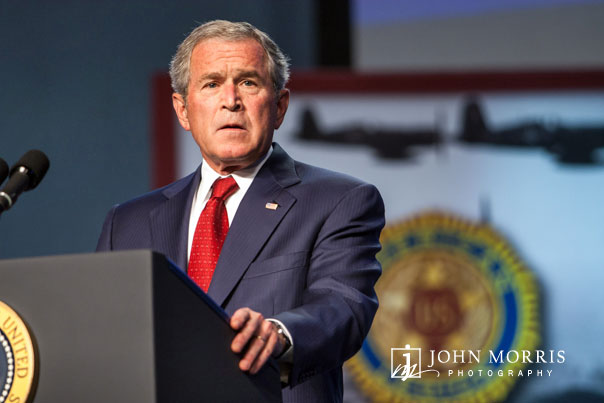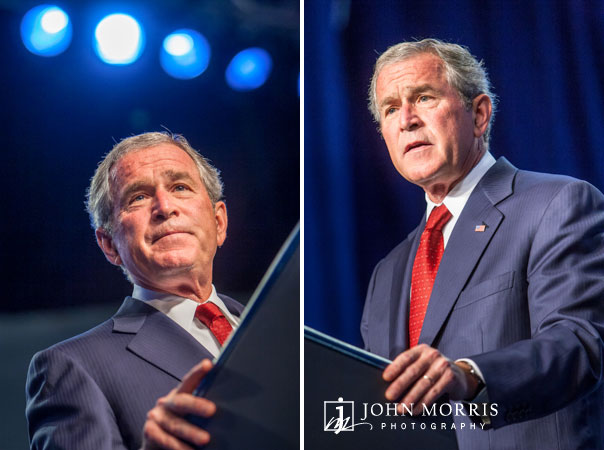
My Scouting Approach for Corporate Events
I shoot corporate events. I also coach aspiring corporate events photographers. Currently located in San Diego, I spent most of my career as a corporate events photographer based out of Las Vegas. If you’re going to work as a corporate events photographer, Las Vegas is a good place to be. Something you will learn about me if you visit my blog often is that I am an anxious person. Preparing and scouting events not only helps alleviate my anxiety, it is also a requirement as a professional photographer. So, when asked if I would photograph then-President George W Bush, I got very excited. I also got very anxious. This is how I scouted and prepared for this particular event.
The President’s keynote was scheduled for 9 am in Reno, NV., in front of a crowd of 1000 American Legion members. Reno is about an 8-hour drive from Las Vegas. I was unfamiliar with the conference hall where the speech would be given so I was not certain of what kind of lighting or access I would have. Should I drive or fly? When should I arrive? The day before, or two days before so that I could scout? Will they let me scout? How close will I be allowed to get to the President while he speaks? What is the lighting like in the room? Can I use a flash? Should I use flash? These are all important questions that you need to ask yourself when preparing for a shoot. You don’t get to hit the reset button when shooting keynotes so you must prepare as much as possible beforehand. Scouting is important.
Getting There. The Logistics of Transportation at Corporate events.
I decided to drive. Time-wise, 8 hours up and 8 hours back is a huge time investment, but I hate what flying has become. I always have to fight to protect my equipment and risk the airlines losing or damaging my gear. Expense wise, the cost of fuel vs. the cost of a round-trip ticket and a rental car was a wash. Additionally, I like to drive and I wanted to use the opportunity to explore Virginia City and Mono Lake for a personal project I had been working on. In order to have time to scout the venue where the President would be speaking, I decided to drive up a few days before. With a late morning start and an 8-hour drive I would arrive later that same afternoon, check in to the hotel and be ready to scout at 9 am, the day before the speech. This would allow me to scout the conference hall during the same time of day that the president would be speaking.
An important part of scouting any location is transportation. Commute time, parking, ease of access, and entry and exit points are all often overlooked aspects of an event’s location. Part of your job as a professional is to be on location and ready to shoot. Knowing how long it will take you to get there, where to park, and how you will get your gear from your vehicle to the event are critical considerations. Even the route you take from your car to the event site must be accounted for. Knowing the logistics ahead of time, helps you prepare for the unexpected and lets you concentrate on the job at hand. Ignore these details and you might find yourself hoping you find a parking spot close and feeling a lot of unnecessary anxiety as you scramble to arrive on time.
Scouting Corporate Events for Lighting
When scouting any location, even an indoor one, I try to scout at the same time of day as the event. I can’t count how many times a wayward skylight, entryway doors or windows have unexpectedly effected a shoot. I am also able to observe the quality, quantity, and color of the light. This way, I can ensure that I am carrying adequate lighting equipment and gel any flashes I might need. Upon arriving at the convention hall I was able to determine that the hall was very big. The ceilings were probably pushing 50 feet making bounce flash ineffective. If I was going to use flash, it would have to be direct. There were entry doors with windows at the very back of the hall which would probably not affect the stage lighting in any way. The main light source for the entire hall was ceiling-mounted, mercury vapor lights. These types of lights emit a magenta if your camera’s white balance is set for daylight. I was able to make all these calculations within just a few seconds. While they are important factors to consider, they were largely irrelevant in this case because of the elaborate stage lighting.

Scouting for Stage Lighting at Corporate Events.
If you’re at all experienced with large, indoor event photography, you would have probably already assumed two things. First, the conference hall would be large with high ceilings. Second, that the podium or stage, where the President would be speaking, would be lit well. Production companies tend to splurge when preparing for keynotes as important as a President’s. In this case, the stage was well lit with tungsten spots and floods. The amount of light I would have to work with was not going to be a problem. It is also important to know the direction and where the lights were coming from. Knowing this, you can determine how the light will fall on your speaker and where the best vantage points will be. I was able to speak with a lighting technician and he briefly brought the stage lighting up to keynote levels. I then metered and recorded the settings a day ahead of the President’s speech. Now I knew that I could handhold, use a low ISO and I wouldn’t need flash.
Not all stage lighting is created equal. When scouting for stage lighting, make sure to identify any hot spots or areas on stage where the light falls off. Hot spots usually occur towards the center of the stage and can result in overexposure. Light fall-off usually occurs towards the front, near the back and on the sides of a stage. This is a factor especially if your subject or speaker is moving during the speech. Pay attention to background lights as well. Overly bright up-lighting, giant led screens, and general clutter can result in overexposure and confusing backgrounds. Look for areas behind and to the side of the stage that make for good backgrounds where you can place your speaker and keep distractions to a minimum.
Corporate Events Scouting. Envisioning The Shoot
Of course, lighting is only part of the equation. Convention hall size, access to the stage or podium, and entry and exit points are critical factors to know ahead of time. I had arranged to meet with the coordinator who hired me at 9:30 am that same morning. She explained that I was to be a member of a press pool and that we would rotate through three different locations during the President’s one-hour speech. She also showed me where the President would be entering and exiting. With this information, I envisioned how the whole event would likely unfold. Envisioning helps me determine the timing of the event, the best locations to be in, and the equipment I will need to make the best shots happen. It also helps me identify and prepare for any potential problems or challenges I might encounter during the shoot.
Speaking with a Coordinator or Production Manager
Twice now I have mentioned speaking with people in the know. Speaking with and communicating with coordinators and production people is critical to the success of a corporate events assignment. While it may seem obvious, I am always surprised when coordinators express appreciation and tell me stories where photographers have not reached out to them. Expectations and important boundaries can be discussed ahead of time which helps avoid problems during the shoot. Unexpected events, beneficial vantage points, and key moments can also be discussed and shared. This can provide you with invaluable information and access you might not have been aware of otherwise. Don’t limit your communication to just coordinators and managers. Stagehands, security guards, and even other photographers can be a great source of information as you scout and prepare for any event.

Putting It All Together
Let’s imagine two scenarios. I will try not to exaggerate in favor of scouting over just showing up. I won’t have too.
After spending approximately an hour scouting the venue in Reno NV, I was able to collect a wealth of information that I otherwise might not have had. Now, I know the general lighting for the entire hall and I know the specific lighting for the various parts of the stage. I have preset my ISO, color temp and exposure settings to begin the shoot. I made contact with the production manager, coordinator and maybe a security guard giving me points of contact should I need anything or have any questions. I know where the President will be standing during his keynote and I have an idea of the best backgrounds. There are three locations where I can shoot from and I know what lenses I will need to take advantage of each spot. I know where the President will enter and exit the stage preparing me for any candid opportunities that might arise. The coordinator has walked me through the sequence of events and I can now envision how the shoot should play out. This helps me plan for any problems or opportunities I might encounter. I received instructions from the Secret Service and I understand what I can and can’t do, where I can be and not be. Am I still anxious? Well yes, I’m an anxious person, but I’m not panicking and I feel ready.
The other scenario. I arrive the night before the shoot. I can get into the hall that evening, but because the lighting is different, I am not sure how the daylight will affect the stage. The production crew and coordinator are done for the day and are nowhere to be found. I can see the venue and know that it will be a direct flash only. I can always dial in the exposure for the stage lighting as the President walks up to the stage. I wonder where he will enter and exit from and where I will be standing. I’m probably going to have to move quickly so I won’t be able to carry a lot of equipment. I hope I have the right lenses at the right time. I have never worked with the Secret Service before, I might have to figure it out as I go. Probably when I fire my flash during the President’s speech. Take a look at some of my corporate events work here http://www.johnmorrisevents.com/portfolio/corporate-event/
